Home > Technical Support > Molding Technology
New Evaluation Method to Identify the Mechanism of Gas Formation During Injection Molding (Part 1)
New Evaluation Method to Identify the Mechanism of Gas Formation During Injection Molding |
|---|
| 1. Introduction |
With the environment surrounding the manufacturing industry changing dramatically, requirements for high quality and high precision resin molded articles are inevitably higher than ever in order to accommodate the needs of our times for electrification and automation of cars, as well as size and weight reduction. In order to meet these requirements, resin materials need to reach an even higher level of performance. We can add new functionality to the resins by forming new compounds from various additives while aiming to achieve higher performance, but harsh molding conditions (high temperature, high speed) and deterioration of the additives can release high volumes of decomposition gases. It is not unusual for these gases to have a severe impact on quality. Particularly in the field of injection molding, mold deposits, gas burns and short shots caused by pyrolysis gas can lead to problems with quality, including undesirable effects on the dimensions and appearance of products. This can lead to a higher defect rate. As a result, many manufacturers are now dedicating a great deal of time and manpower to solving these problems. For example, to maintain a high level of quality in a molded article without causing any defects, you could frequently adjust the gas vent as shown in Figure 1. In many cases, the resulting maintenance cost has led to rising manufacturing cost, which has been responsible for a loss of price competitiveness. |
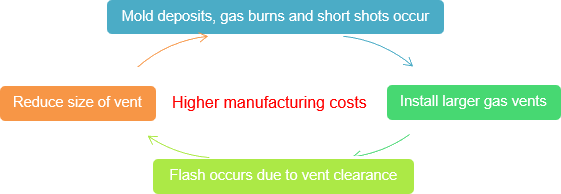 |
Figure 1 : Example of a defect cycle and increase in manufacturing costs |
|---|
Plastics which are used for injection molding inevitably release decomposition gases when subjected to high temperatures. However, we were still unaware what mechanism causes these pyrolysis gases to form. This is because the phenomenon occurs inside the mold, which is essentially a black box. Since the mechanism is unclear, it is quite a challenge to figure out the right measures to counter the problem. To address this, we worked on developing our own proprietary method to capture and evaluate the gases formed during molding. These efforts were successful. We named it the Gas Investigation Method in Injection Molding (GIMIM), and using this method we were able to discover the mechanism by which pyrolysis gas forms during injection molding. Here we will provide an overview of the mechanism of gas formation during molding which we learned of through GIMIM, and of mold deposits in general. |
| 2. Development Background |
| 2.1 Occurrence of mold deposits |
Mold deposits is the general term used to describe the buildup that gets stuck to the surfaces, gaps, and parting lines of the mold during injection molding. Mold deposits have various causes, and we have compiled some of the more common causes in Table 1 below. |
Table 1 : Causes and examples of mold deposits |
| Pyrolysis of pellets | Blooming from pellets | Causes other than pellets |
Monomers Oligomers Elastomers Additives Colorants Stabilizers Mold release agent Lubricants |
Stabilizers Mold release agent Lubricants |
Chemicals on mold surface Processing oil Cutting oil Rust inhibitor Delamination of molded articles Residuals left in the cylinder due to insufficient purging |
In addition to pyrolysis in molded resins, mold deposits can occur due to blooming and delamination, and it is not uncommon for mold deposits to also occur due to unexpected causes other than the molded resins. Mechanisms by which mold deposits occur are illustrated by the schematic in Figure 2 below. Mechanism (1) shows how mold deposits occur due to delamination of the molded articles, and we will not be discussing this in detail here. What we will explain are mold deposits occurring due to physical adsorption as shown in (2) and chemical adsorption as shown in (3). |
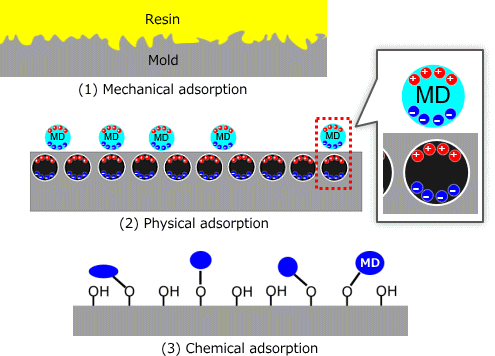 |
Figure 2 : Mechanisms that cause mold deposits |
|---|
(1) Physical adsorption |
Mold deposits are adsorbed to positively charged metal surfaces by Van der Waals force. This is considered to be the most fundamental principle in the adhesion of mold deposits to the mold. |
| (2) Chemical adsorption |
This occurs when electrons are shared between surface layer atoms in covalent bonds and hydrogen bonds. It causes mold deposits to form more easily on the physical adsorption layer in (1). |
| 2.2 Existing evaluation methods and challenges |
There are many different analytical methods to investigate the causes of mold deposits caused by pyrolysis gas during injection molding. These can be broadly classified as methods that heat pellets and analyze the resulting volume and composition of decomposition gases (referred to here as pellet-based methods), and methods that actually perform molding and analyze the resulting mold deposits that adhered to the mold (referred to here as mold-based methods). Pellet-based methods send gases formed by thermal decomposition to analyzers in order to determine their composition and volumes. Normally, gas chromatography mass spectrometers (GC/MS) are used, but flame ionization detectors can be used to perform even more sophisticated analyses. However, even though the analysis is high precision, the concept is considered to be significantly removed from the actual molding process since it does not reflect the heating process of the molding machine, and the analysis is performed in an inert gas atmosphere. In contrast, mold-based methods deal with the actual mold deposits adhered to the mold, so these methods are considered to be close to the actual molding process. These methods are therefore widely used, one example being the mold deposit weight method. This method repeatedly performs actual molding and observes the degraded materials in terms of the weight and appearance of mold deposits that actually adhere to the mold. However, mold-based methods also do not match the actual results in many cases, since these methods are highly dependent on the environment, including the molding machine itself and the structure of the mold. At Polyplastics we have addressed gas and mold deposit-related problems by engineering the performance of our materials using the analyzers and mold-based methods above, and we have leveraged our accumulated knowledge of resin materials and molding technologies to propose a wide variety of measures for mold maintenance cycles and gas problems. However, sometimes we encounter cases that are hard to explain. We believe this is mainly because the mechanism involved in the formation of gas during molding has not been sufficiently identified. Investigating the mechanism by which gas forms during molding was made more difficult by the various incoherent hypotheses that existed, and the low reproducibility of these gas-related problems.
We addressed these circumstances by developing an innovative method of evaluating pyrolysis gas that forms during the molding process, and plotting out the correlation between materials, molding machines, molds, gases and problems related to gas and mold deposits, which had previously been hard to connect. We are now able to explain this mechanism and propose new measures to address it. |
| 3. Technology Overview |
The Gas Investigation Method in Injection Molding (GIMIM) is a hybrid evaluation method of mold-based methods, using the analyzers described in 2. Development Background above. Polyplastics' innovative proprietary method traps gases according to mold-based methods, uses gas chromatography mass spectrometers (GC/MS) to qualitatively and quantitatively analyze their composition, identifies the gases that are formed, and makes fundamental improvements to the sources of their formation. This evaluation system is illustrated in Figure 3 below. |
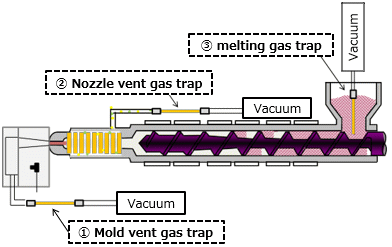 |
Figure 3 : Overall system configuration of the molding gas evaluation method |
|---|
This simple system configuration is divided into the three-stages of plasticization, metering, and injection, and each unit is fitted with gas traps to be able to seclude the gases that form within each part of the process. We then perform around 1 to 10 shots of actual molding depending on the purpose and use a GC/MS to analyze the gases that are formed. When simply analyzing molded articles and resin pellets using a pyrolysis GC/MS (Py-GC/MS), the gases that form do not have the same thermal history as those in actual molding. The measurement environment is inert gas, which means that the environment is very different from the environment during molding. In contrast, GIMIM can reflect the actual circumstances during molding by directly trapping and analyzing the gases formed during molding. This difference is thought to be what had caused the divergence from what was actually occurring. Table 2 shows a comparison between these environments. GIMIM makes it possible to measure high molecular weight substances that can cause mold deposits. GIMIM is a high-accuracy analysis method close to the actual phenomenon that it analyzes. It further evolves the reproducibility of mold-based methods which are close to this actual phenomenon, and adds the advantages offered by high-accuracy analyzers. |
Table 2 : Comparison of GIMIM and GC/MS |
| GIMIM | Py-GC/MS | |
| Environment | Air | He |
Thermal history |
Complex, compound temperature profile of shearing heat, friction heat, heat from heaters, etc. |
Primary simple temperature profile in Py-GC |
Result value |
Mainly high molecular weight substances |
Mainly low molecular weight substances |
Description of evaluation results |
|
| ⅰ | Low molecular weight substances (low boiling substances): Substances that are easily emitted in gas form at mold temperature (℃) during molding. Detected on the short time period side of retention time (RT) in GC/MS. These substances do not easily cause mold deposits. |
| ⅱ | High molecular weight substances (high boiling substances): These substances adhere more readily to the mold as liquids or solids at mold temperature (℃) during molding. Detected on the long time period side of retention time (RT) in GC/MS. These substances cause mold deposits more easily. |
| 4. Mechanism of Gas Formation during Molding |
We trapped the gas forming beneath the hopper during plasticization/metering in (3), gas forming in the metering part in (2), and gas forming within the mold during injection in (1) and analyzed them. The results are shown in Figure 4 below. |
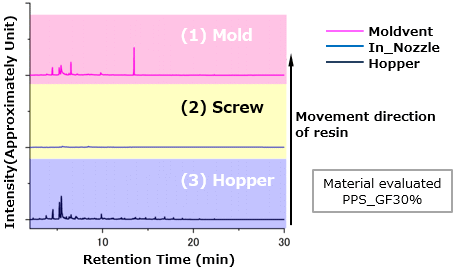 |
Figure 4 : Measurements of each process from pellet feeding to injection |
|---|
Many peaks are observed during (3) plasticization (beneath hopper) and (1) injection (inside the mold). Hardly any peaks at all are observed (in the metering part) during metering (2). Large amounts of gas form during plasticization and injection when the resin receives a significant amount of friction heat and is exposed to air. However, contact with oxygen is held to a minimum during metering, and it seems that not enough gas to detect is generated from a few shots. Looking at this overall trend, we can probably say that the gas formed during plasticization is discharged from the hopper side, and gas flowing into the mold is formed during injection. Next, using thermography to observe resin coming out of the nozzle, we were able to confirm that thermal history at the time of injection was causing temperature increases dependent on injection speed (Figure 5). The left side of the illustration is during drooling, and the right side is during injection. We can see that the resin is hotter during injection. Table 3 below compiles the resulting resin temperatures observed in these various molding conditions. Depending on the conditions, we can see that we are causing temperature increases of 100℃ or more compared to temperatures during drooling. |
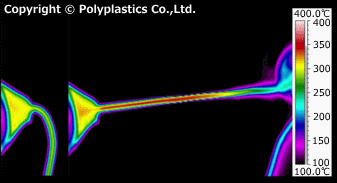 |
Figure 5 : Temperature measurements of injected resin via thermography |
|---|
Table 3 : Injection speed and resin temperature measurements |
| Grade | Cylinder temp [℃] | Injection speed [mm/s] | Temperature measured [℃] | ||
| At drooling | At injection | Temp change | |||
| GF30% PPS | 300 | 30 | 280 | 321 | 41 |
| 100 | 363 | 83 | |||
| 340 | 30 | 305 | 345 | 40 | |
100 |
382 | 77 | |||
| 200 | 423 | 118 | |||
*Using a FLIR T640 (resolution: 640×480) |
From the results of this experiment, we can see that gases made of high molecular weight substances which cause mold deposits are forming because resin dramatically increases in temperature just past the nozzle during injection, and not during plasticization or metering. |
| 5. Conclusion |
Here we introduced the new GIMIM method for measuring and analyzing pyrolysis gas formed during injection molding. Since this method directly analyzes gases that are formed inside the mold during filling, we believe it yields results that are closer to reality. We would like to take this study even further and use it to develop concrete measures against mold deposits caused by gas. Next time we will introduce measures that can be taken against problems caused by pyrolysis gas such as short shots and gas burn defects, as well as mold deposits. |
[Related information] |
Technical data sheet is available online: |
|
||
For inquiries about our technologies |
◆Polyplastics Group Representative | ||
| ◆WEB Inquiry |
13th July 2021 |

